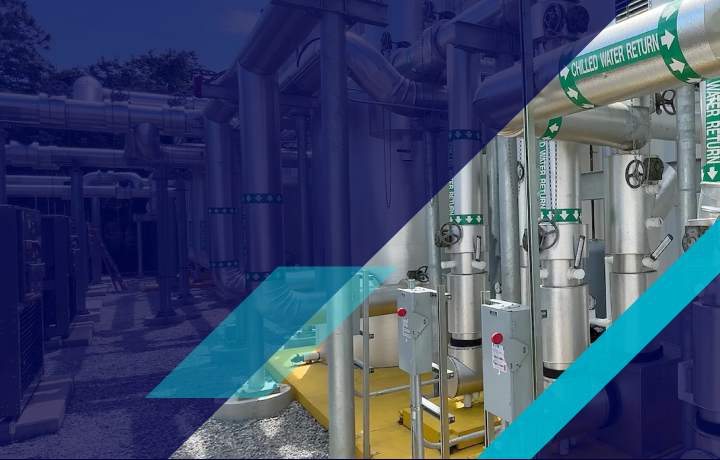Liquid cooling in data centers: A deep dive
With artificial intelligence (AI) heavily influencing business infrastructure and the data center industry striving for optimal operation, cooling technology plays a pivotal role. As we push the boundaries of computing power, traditional air-cooling methods are being outpaced by more efficient, innovative solutions. Among these, liquid cooling stands out as a game-changer for its efficiency, performance enhancement, and energy-saving capabilities. Flexential, with its extensive network of data centers across 19 US regions, is at the forefront of adopting such advanced liquid cooling options and solutions to cater to our clients' evolving needs.

The importance of cooling in data centers
The heart of a data center's efficiency is its ability to manage heat. Considered a critical factor in data center tier classification, a data center’s ability to deal with excessive heat—which can lead to hardware failure, reduced performance, and increased energy consumption—is vital. We have covered everything you need to know about data center cooling and how it improves performance and avoids downtime and unforeseen issues. This article will focus on the heat generated by today's high-density, power-intensive computing environments and why liquid cooling is a more efficient way to remove heat directly from the source.
Understanding data center liquid cooling
Liquid cooling uses a liquid coolant to absorb and dissipate heat from data center components. Unlike air, liquids can carry away more heat more efficiently due to their higher heat capacity. This method is more effective and allows for closer component packing, reducing space requirements and facilitating better performance from existing data center infrastructure, and one of the critical elements of an AI-enhanced data center.
Evolution of data center cooling technology
From air to liquid cooling
The transition from air to liquid cooling represents a significant leap in data center technology. Initially, air cooling was sufficient, but as server densities increased, the limitations of air cooling infrastructure became apparent. Liquid cooling emerged as a solution capable of handling the greater thermal loads of modern data centers without the drawbacks of air cooling systems.
Modern innovations in liquid cooling
Today's liquid cooling technologies include immersion cooling, where components are entirely submerged in a non-conductive liquid, and direct-to-chip cooling, which involves circulating coolant directly to the heat-generating components. These methods offer unparalleled efficiency and cooling effectiveness.
Why liquid cooling?
The efficiency of liquid cooling
Liquid cooling stands out for its ability to efficiently manage the thermal output of data centers and is one consideration when choosing a data center provider. By directly absorbing heat from components, liquid cooling systems can significantly reduce the energy required for cooling, translating into lower operational costs and a smaller carbon footprint.
Enhancing performance and longevity
Keeping components at optimal temperatures boosts their performance and extends their lifespan. Liquid cooling ensures that even the most heat-intensive operations can run smoothly, supporting the uninterrupted performance of critical applications.
Reducing energy consumption
One of the most compelling benefits of liquid cooling technology is its potential to lower energy consumption. Using efficient heat transfer mechanisms, data centers can achieve significant energy savings, contributing to sustainability goals and reducing operational costs.
Types of data center liquid cooling techniques
Immersion cooling
Immersion cooling involves submerging server components in a thermally conductive but electrically insulating liquid. This highly efficient heat removal technique makes it ideal for high-performance computing environments.
In-rack liquid cooling
In-rack liquid cooling solutions bring the cooling directly to the rack level, ensuring targeted cooling of high-density setups. This method is versatile and can be adapted to various data center layouts.
Cold-plate cooling
Cold-plate cooling involves attaching a cold plate directly to the component or processor. A coolant is then circulated through the plate, absorbing heat directly from the source. This method is effective for cooling individual high-heat components.
Components of a liquid cooling system
A comprehensive liquid cooling system includes several key components, such as coolant distribution units, heat exchangers, pumps, liquid-cooled server racks, and cooling fluid. Each plays a crucial role in ensuring the system's efficiency and reliability.
Coolant distribution unit
The Coolant Distribution Unit (CDU) is essentially the heart of the liquid cooling system. It is responsible for managing the coolant flow, ensuring that it is distributed evenly and at the correct temperature across the system. The CDU monitors the system's pressure, temperature, and flow rate, adjusting parameters dynamically to maintain optimal conditions for heat transfer.
Heat exchangers and pumps
Heat exchangers are vital in transferring heat from the coolant to a secondary fluid, often water, which is cooled using external systems. Pumps circulate the coolant through the system, maintaining a constant flow to ensure efficient heat removal. The design and efficiency of pumps and heat exchangers significantly influence the overall effectiveness of the liquid cooling system.
Liquid-cooled server racks
Liquid-cooled server racks are designed to integrate seamlessly with liquid cooling systems. They contain specialized mounts and interfaces for direct-to-chip or immersion cooling systems, enabling direct heat transfer from the servers to the liquid coolant. The racks are also designed for leak prevention, airflow, and ease of access for maintenance.
Cooling fluid
The cooling fluid is selected based on its thermal conductivity, electrical resistance, and chemical compatibility with system components. Common fluids include water, glycol mixtures, and synthetic oils, each chosen for their unique properties to suit specific operational requirements.
Evaluating the efficiency of liquid cooling
When assessing a liquid cooling system's efficiency, metrics such as heat removal capacity and energy usage are vital. These indicators help determine the system's effectiveness in managing the data center's thermal load and its impact on overall energy consumption.
Metrics for measuring efficiency
Efficiency in liquid cooling systems is measured using metrics like Coefficient of Performance (CoP), Energy Reuse Effectiveness (ERE), and PUE (Power Usage Effectiveness). These metrics help data center operators and managers understand how much cooling is achieved per unit of energy consumed.
Heat removal capacity
Heat removal capacity measures a system's ability to transport heat away from the components. It is typically measured in watts and depends on the system's design, including the coolant's flow rate and the materials' thermal conductivity.
Energy usage
Energy usage is a critical consideration when evaluating the efficiency of a liquid cooling system. It involves the energy required to run pumps and CDUs and the potential savings from reduced need for air conditioning and the ability to reuse waste heat.
Data center liquid cooling implementation considerations
Implementing liquid cooling in a data center requires careful consideration of space and layout, infrastructure costs, and maintenance requirements. Each factor must be balanced to achieve the optimal cooling solution for the data center's needs.
Space and layout considerations
Implementing a liquid cooling system in a data center requires careful space utilization and layout planning. Liquid cooling equipment typically requires less space than air handlers, but the layout must accommodate fluid distribution systems and maintenance access.
Infrastructure costs
The initial investment for a liquid cooling system can be higher than traditional air cooling. However, the return on investment can be realized through improved energy efficiency, higher-density computing, and potential infrastructure simplification.
Maintenance and upkeep
Maintenance of liquid cooling systems involves routine checks of fluid levels, pump function, and system integrity to prevent leaks. Regular monitoring ensures that the system operates efficiently and helps to avoid downtime due to equipment failure.
Choosing between different data center thermal management systems
The choice between air-cooled, liquid-cooled, and hybrid cooling systems depends on each data center's specific requirements and constraints. Factors such as the computing environment, energy efficiency goals, and budget constraints are crucial in this decision-making process.
Air-cooled data center
Air-cooled systems are common and relatively easy to implement. They are suitable for lower-density computing environments where the thermal load is within the capabilities of air-based heat dissipation.
Liquid-cooled data center
Liquid-cooled data centers are ideal for high-density and high-performance computing environments. They provide efficient heat removal, enabling closer component packing and greater compute capacity within the same footprint.
Hybrid cooled data center (air/liquid cooling system)
Hybrid systems combine the benefits of both air- and liquid cooling. They are versatile and can be tailored to specific zones within a data center, providing efficient cooling where needed and using traditional methods elsewhere.
|
Want to learn more about how Flexential liquid-ready data centers can support liquid cooling applications today as machine learning workloads and other GPU applications are becoming the predominant users of data centers? Download our liquid cooling application guide. |
In conclusion, liquid cooling in data centers is not just a trend but a necessary evolution to meet the demands of modern computing. By embracing this technology, Flexential ensures its data centers are capable of handling the heat and doing so in the most efficient, environmentally friendly way possible. For businesses looking to optimize their data center operations, liquid cooling offers a compelling solution that promises improved performance and significant cost and energy savings.
This article aimed to cover the essentials of data center liquid cooling, focusing on its importance, types, benefits, and considerations for implementation. For those interested in exploring how Flexential can help optimize your data center operations with liquid cooling solutions, we invite you to schedule a consultation and learn more about our services.





